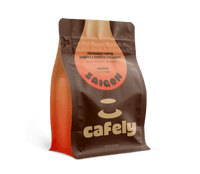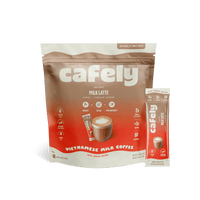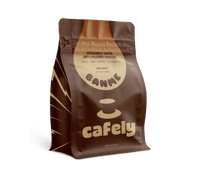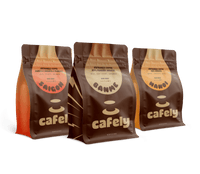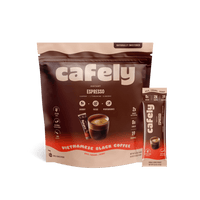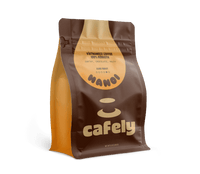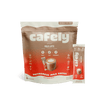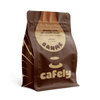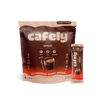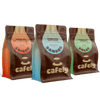This traditional recipe combines the bold flavors of Vietnamese robusta coffee with the savoriness of sea salt and the creaminess of condensed milk.
It’s a refreshing and surprisingly harmonious drink that’ll leave you craving another cup morning after morning.
If that sounds like coffee heaven, here's the full recipe. Perhaps your morning coffee routine needs a little shakeup, or you're a dedicated coffee enthusiast looking for something new.
Read on to learn everything you need to know about making Vietnamese sea salt coffee.
What You’ll Need:
Brewing Vietnamese sea salt coffee couldn’t be easier — here’s what you’ll need to get started:
- Two tablespoons of coffee grounds — such as Cafely’s Sai Gon OG blend. The grounds are the heart of the drink, and they make for a robust and smooth base.
- Hot water — Add just enough to brew the coffee with the signature phin filter.
- Two teaspoons of fine sugar — It doesn’t have to be the exact amount. Do more or less according to taste.
- 1/4 teaspoon of sea salt — Sea salt is the obvious ingredient that makes this drink unique.
- Ice cubes — This coffee is marvelous when cold, so add some to chill and dilute the coffee to perfection.
- 1/4 cup of milk or cream — Adds a creamy texture and rich flavor, a signature of traditional Vietnamese coffee.
Step-By-Step Instructions: Vietnamese Sea Salt Coffee
Now that you have all the ingredients, it’s time to brew. Have the grounds, ice cubes, and milk or cream ready, and remember to prepare the shaker. You’ll want this coffee shaken, not stirred.
1. Prepare Your Coffee (Phin Filter)

Place your fine ground coffee in a phin filter and set it over your cup. Slowly and carefully add hot water and let the coffee drip through until it just barely covers the grounds.
Wait 45 seconds for your coffee to “bloom” before pouring in the rest of the water — filling it up to just below the top of the phin filter.
Let your coffee drip for 5–7 minutes until the phin stops dripping. If you don’t have a phin filter, use a French press instead.
2. Mix With Sea Salt & Condensed Milk

Mix the condensed milk or cream, sea salt, and freshly brewed coffee in a shaker. Seal and shake until everything is fully dissolved, and you can no longer see any specks floating about.
3. Add Ice (Optional)

Add ice cubes to the shaker and give it a vigorous shake. The ice cubes will chill the coffee and add a slight frothiness, making a shakerato what it is. After all, that's how it got its name.
4. Stir & Serve

Pour your coffee into a cup, either hot or over ice, give it a final stir, and serve.
You'll see that the contrast between the creamy milk, the bold coffee, and the hint of saltiness is absolutely divine. Just don't wait around too long.
Make It Your Own Using Other Flavors
The great thing about Vietnamese sea salt coffee and shakerato is that you can make them your own, even with little alterations.
Feel free to modify the amount of sugar, salt, and milk to suit your taste or the tastes of your guests.
Some people like a bolder coffee flavor, cutting down on the milk or increasing the coffee-to-water ratio.
Others enjoy a sweeter, creamier take on the exquisite coffee by adding an extra dose of cream or milk to the final brew after shaking.
Related: What does Vietnamese Coffee Taste Like?
How Salt Makes Vietnamese Coffee Taste Better
At first glance, adding sea salt to a cup of coffee might seem like a curious, even bizarre choice. However, salt's power is that it's a flavor enhancer. In the right proportions, it can turn a good coffee into an extraordinary one, just as it can with a savory meal.
The salt cuts through the bitterness, highlights the coffee's natural sweetness, and dulls any sweet aftertaste. It adds a certain depth of flavor that sweeteners alone can’t achieve. Also, when using a premium blend like Cafely's SaiGon OG, every nuanced note of the coffee will be even more pronounced with just a fairly small dose of salt.
What Kind of Coffee Works Best For Vietnamese Sea Salt Coffee?
We recommend using any dark roast Vietnamese robusta or robusta-arabica blend for making this coffee. The dark, intense, and full-bodied qualities of robusta produces the best flavor for this style of coffee.
Cafely offers 4 deliciously bold robusta coffees:

- HaNoi — A pure, 100% Vietnamese robusta.
- SaiGon OG — Our signature coffee, blending robusta, arabica, & peaberry.
- BanMe — Our strongest coffee. Made exclusively from shade-grown peaberry robusta.
- DaNang — A 50/50 blend of robusta & arabica coffees.
FAQs: Vietnamese Sea Salt Coffee

Next, we’ll answer some questions about Vietnamese coffee.
1. How do you make traditional Vietnamese coffee?
Making a traditional Vietnamese coffee requires a phin filter and a special robusta coffee bean, such as Cafely's HaNoi. Add sweetened condensed milk once you brew the coffee, usually two or three teaspoons, depending on how sweet you like it. You can also add cream or milk and sugar. Add ice if you want it cold.
2. How much caffeine is in Vietnamese coffee?
If you're wondering what makes Vietnamese coffee so strong, know that it has about 100 mg of caffeine in each cup (or 60 mg per 2 oz). Regular brewed coffee has about 60 mg per cup, and espresso has about 64 mg per ounce. Caffeine amounts vary depending on how much coffee is used, how long it’s brewed, and whether you’re using robusta or arabica beans.
3. What else can I add to Vietnamese coffee?
If you want to avoid dairy, try coconut cream, almond milk, or oat milk. Keep it low-calorie by using a sugar substitute. Even vanilla ice cream has been used to substitute the condensed milk, though nothing quite matches the flavor.
Related: Vegan Vietnamese Coffee Recipe
4. Is Vietnamese coffee always served hot, or can it be enjoyed cold as well?
Vietnamese coffee can be enjoyed both hot and cold. To make it cold, simply brew the coffee using the traditional method, then pour it over ice. It's a refreshing option, especially during warmer weather.
Related: How to Make Vietnamese Cold Brew?
5. What makes Vietnamese coffee different from other types of coffee?
The unique aspect of Vietnamese coffee lies in its preparation method and ingredients. Traditional Vietnamese coffee often uses robusta beans, which impart a bold and intense flavor. Additionally, the use of sweetened condensed milk instead of regular milk or cream adds a distinctive sweetness and creaminess to the beverage.
6. Are there any specific rituals or customs associated with drinking Vietnamese coffee?
Yes, drinking Vietnamese coffee is often seen as a social activity or a time for relaxation. It's common for people to gather at local cafes, known as "ca phe," to enjoy a cup of coffee together. Additionally, the slow drip process of brewing coffee using a phin filter encourages savoring the experience, making it a leisurely affair rather than a quick caffeine fix.
